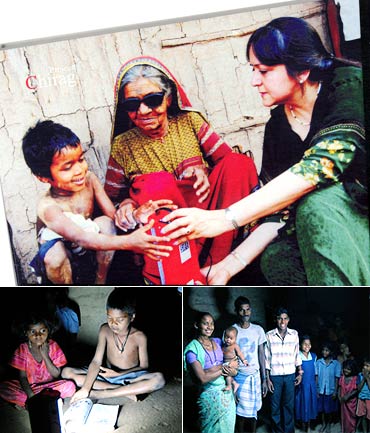
Mohan Bhargava, the reel-life NASA scientist portrayed by Shah Rukh Khan in Swades who lights up his native village using hydro power can take a walk. A bunch of young college students -- no scientists, these -- have done the same in real life, in a simple, innovative way through their passion, innovation and ingenuity.
The striking part, though, is the speed with which they have executed their idea. They conceptualised it on January 11, 2010, and by March 12 had accomplished their task of lighting up 82 out of a total of 111 homes in a tribal village in Thane district of Maharashtra.
What's praiseworthy is that in less than 100 days a group of 250 college students managed to win the faith of the tribals -- without which Project Chirag (more about it later) would have been a "super flop" -- raised a "humongous amount of money" (their own words), selected a vendor who gave them the technology to produce quality solar lamps, trained a disadvantaged section to assemble the lamps, trained their own volunteers to impart training to the assemblers, transported and installed solar lamps in this village and sold these lamps that costs them Rs 3,650 a piece for just Rs 500 to make Project Chirag a reality.
In doing so, they have created a value chain of several disadvantaged communities -- both rural and urban -- that has the true potential to transform the country's landscape.
According to some estimates, approximately 400 million people in India do not have access to electricity and it is this gap these students aim to bridge.
With guidance and encouragement from their college professor Pratibha Pai and principal Indu Shahani (who also happens to be Mumbai's sheriff), more than two score students of HR College of Commerce & Economics lit up Ujjaini, a tribal 'dark village' deep in the forest, spread across a radius of two km and made up of 111 households, barely 110 km from India's financial capital Mumbai in Wada tehsil in Thane district.
Rediff.com met five of these activists -- Jyotirmoy Chatterji, Prachi Bali, Abhinav Mehra, Afsheen Irani and Pawan Bhatia (all under 23 years of age) -- in their college canteen to discuss Project Chirag started by the Students In Free Enterprise, HR College.
Project Chirag
"A village that does not have any source of electricity or does not have even one electrified household. is a 'dark village'," explains Jyotirmoy, a third year commerce student and president of SIFE, HRC.
"Project Chirag is about lighting up rural life using clean and sustainable solar energy," he says.
And these volunteers chose Ujjaini out of a list of 30 dark villages in Thane district that the Tata Energy Research Institute provided them with "because the tribal folks here have never seen light in their entire life".
The solar lamp unit is a portable LED (light emitting diode) device that comprises a solar lantern, a battery inside protective casing, a tubelight and two solar panels that capture sunlight and convert it into light energy.
"All one has to do is put two panels on the rooftops of these tribal houses where one can get maximum sunlight, connect the wires coming out of these panels into a battery which in turn energises the tubelight and lantern and they are ready to go," says Afsheen, a second-year student at HRC who has trained many tribals in Ujjaini to work on these lamps.
Image: Clockwise from top: A grandmother with impaired vision excited that her grandson can finally experience light; A happy Ujjain family; Tribal children reading a book under solar lamps.
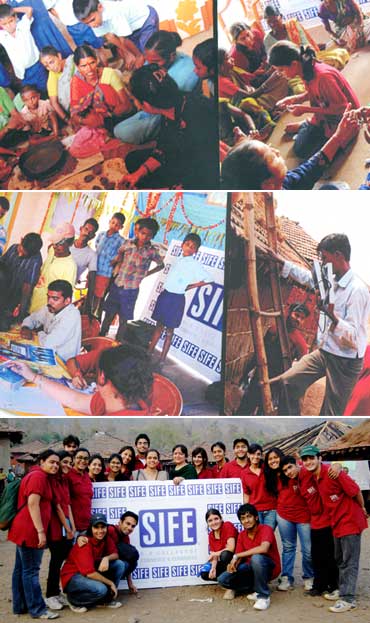
SIFE HRC, established in 2008, was initially concentrating more on urban projects. But soon the volunteers felt the need to glance at exploring sustainable business models for rural development as "a majority of Indians still live in its villages".
"So when we got a list of dark villages from TERI we randomly picked up one village that was populated and without any kind of guidance took a car and wandered into the forests to find Ujjaini," says Abhinav, Jyotirmoy's classmate.
After coming back from Ujjaini they decided to work on a five-point transformation model that was scalable and could be applied to any dark village in rural India.
This five-point plan would look at a holistic solution to transform rural lives and provide for:
"Phase I of Project Chirag is to electrify dark villages using solar lighting because achieving the remainder of the four points in the transformation model depend on lighting up villages first," says Prachi, a third-year commerce student.
During their trip to Ujjaini the students found that the tribals spent a lot of the day, their productive period, going into the forests to collect firewood to light up their homes or cook food.
"So we thought introducing solar lighting would help them use their time productively," explains Prachi.
Why government is important
While their motive was noble, it wasn't going to be an easy task. They knew that the key to Project Chirag's success lay in winning the tribals' trust. After all, they were the biggest stakeholders in the entire exercise and making them understand the benefits of Project Chirag was very crucial for its implementation and further spread.
Hence they needed somebody who would introduce the SIFE HRC volunteers to the tribals and act as a facilitator. With the help of their college principal they managed to get an appointment with Jayant Patil, Maharashtra's rural development minister who, after listening to their five-point transformation model, was mighty impressed and helped them touch base with deputy COO of Thane zilla parishad, Deepak Waigankar.
"When we went to Ujjaini with him we understood how important he was, for the villagers gave us a grand welcome," says Pawan, a second-year commerce student, talking about how they managed to break the ice with Ujjaini's inhabitants. That meeting, which also included Ujjaini's gram sevak and block development officer, helped these students establish trust among the tribals.
"Obviously, they would feel more comfortable with the involvement of a body like the zilla parishad (a local self-government organisation) rather than dealing directly with a bunch of enthusiastic students who were total strangers to them," adds Prachi.
No matter how good their ideas were, they could not execute them without the help of the existing government machinery. Only after that were the people receptive of their ideas and plans.
"Today they know us by our faces and call us the 'light people'," says Prachi, a third-year commerce student, with a big smile.
Image: Clockwise from top left: SIFE HRC volunteers training village women in using soil to make artefacts; Training to make garlands; Installing solar panels; SIFE, HRC volunteers at Ujjaini; Villagers register for light by paying Rs 500.
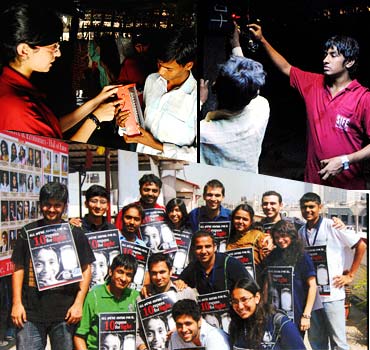
Now that Ujjaini's trust was won, the next important step for SIFE HRC volunteers was to collect funds to buy solar lamps to light up the village and seek a vendor who would provide them with these lamps at a reasonable cost.
They accidentally chanced upon a social entrepreneur, one Mr Kumar -- who is quite secretive about his identity and has requested these students not to reveal more about him -- who agreed to sell them at a nominal cost of Rs 3,650 per unit that would include one LED-powered lantern, one tubelight, one battery encased in a protective cover, two solar panels and wiring.
"To light up entire Ujjaini comprising 111 households at the cost of Rs 3,650 per unit we needed Rs 4,05,000, a rather difficult task for us college students," says Jyotirmoy.
They had never engaged in this kind of money-raising exercise, but it had to be done. Going to corporates would not have been of much help because these students only had a noble idea with no history, no record, nothing that could prove their sincerity and ability to execute a project of such enormity to corporate bigwigs.
"Why would anybody give us that kind of money?" they would often think aloud at their meetings to brainstorm over ways to raise money.
As they say, adversity is the father of all inventions, so these college kids, facing a financial crunch, started thinking about their strengths. After a few days they got their Eureka moment. They were 6,000 students in all and if each one of them contributed even Rs 10, they thought, they would have made a small beginning.
"At the very next moment we came up with a slogan: Rs 10 for light," says Abhinav.
"We could have easily gone to rich bakras in our college and they would have donated us the money we wanted. But we wanted to make change affordable," says Jyotirmoy, elaborating on the fact that they wanted their entire college to partake in this noble affair without burdening any one student.
They had heard a lot of young people in their college talking about bringing in change so they thought their idea could give the youth in their college a chance to become part of that transformation.
The idea was to make all feel proud about their little contributions. "Let's not make even a peon feel that just because s/he is a peon s/he cannot help bring about real, meaningful change in our society," says Afsheen.
"If anybody can afford to save Rs 10 every day of the year s/he could easily muster the Rs 3,650 needed to buy one unit of the solar lamp," says Prachi.
All the students from junior as well as degree colleges came together and unanimously decided to work on it. They wanted to experience the thrill and joy of getting something beyond a college award or a passing certificate.
They wanted to prove a point to all those (read: government, corporates) who always talked about improving the lives of the backward and the disadvantaged, who have the money to bring about that change but have not brought about the change they could.
"We wanted to prove a point that if students of one college can collect the money and light up a village, what kind of tremendous change can corporates and governments bring about given the resources they have," says Afsheen.
Image: Clockwise from top: SIFE HRC volunteers installing solar lamps and tubelights inside a tribal's home; Volunteers with Rs for light placards.
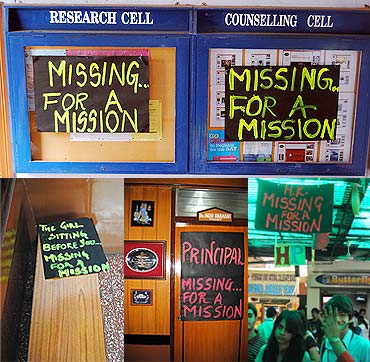
The main talking point about India today is that we have the youngest demographics in the world. We want to prove to our countrymen that India's youth understand their responsibility and as students of SIFE HRC we have taken this initiative to prove a point that this (shortage of electricity production) is a problem and we are addressing it."
But big talk apart, they still had to collect the money which was so very important for lighting up Ujjaini. And to make college students fork out this kind of money warranted a campaign that must rival the best ad blitz in the world through a simple message.
SIFE HRC volunteers found this simplicity in just four words: 'Missing For A Mission'. This not only created a buzz in the college but also culminated in their coffers swelling by more than they had bargained for.
In the first phase of this campaign tubelights and other sources of light were taken off from all the common spaces like corridors (done by a team of 250 students and support staff of the college) and posters were pasted at vantage points that said 'Tubelights missing for a mission'.
"The darkness in the corridor really made a lot of students understand how people with no electricity feel," says Pawan.
To sustain the momentum that the missing tubelights had created, they put placards inside the men's loo that said 'The person standing before you is missing for a mission'.
On the staircase they wrote 'The person walking before you is missing for a mission'; the canteen benches said 'The person who ate before you is missing for a mission'.
That set the ball rolling with each and every student wondering what and why is everything and everybody missing for a mission.
While the curiosity of the entire college was palpable, only 250 out of the 6,000 students knew exactly what was happening. But then, it was also important to hammer their minds with the message when they were not in college so as to sustain the momentum.
"Facebook was the best place to catch them when out of college," says Prachi about their strategy to catch students' attention outside college.
They created a group on Facebook 'Missing for a mission. To know what it is join' and within a month they got 950 followers from Germany, Australia, Malaysia -- all genuine people -- who said they were willing to help them in their mission, whatever it was.
This created a crazy buzz around their campaign and helped create awareness among all the college students.
The final day's campaign completed the slogan: 'These many Indian villages could be lit up with your help only if you could give Rs 10 for lighting up a rural home'.
As expected, most students donated more than Rs 10. Some didn't drink a small bottle of cola one day and contributed Rs 10, some of them didn't eat chips for a day to contribute, some travelled by bus instead of a cab to contribute Rs 10.
In the four days after our campaign was unveiled the 250 volunteers with sandwich boards across their chests, saying 'Rs 10 for light', with receipt book in their hands (they wanted every penny they collected to be accounted for, lest somebody alleged 'paisa kha gaye'), moved around the college and managed to collect a whopping Rs 5,15,000!
That was the power of Missing For A Mission.
Image: The 'Missing For A Mission' campaign.
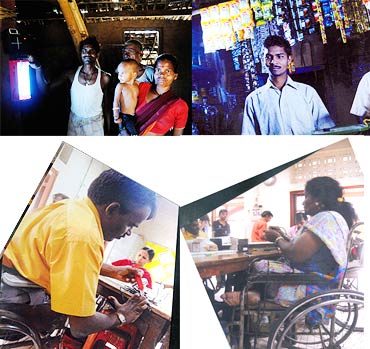
Now that the money was arranged, the next challenge was not only to find a vendor who would provide them with solar lamp units at affordable prices but also assure their supply at short notice. The students were sure that given the cost at which they were to sell these lamps (Rs 500 for a Rs 3,650 lamp), they would go like hot cakes.
"We wanted a vendor who was as passionate as us. There is this person Mr Kumar, who knows the technology to make solar lamps, and who we met through a contact, and was ready to share his know-how with us without charging us any extra amount. His only condition was we should provide him with a disadvantaged community who, he said, he will train to make solar lamps so that they can also uplift their lives economically," says Jyotirmoy about their secret benefactor.
First they sent 10 to 12 SIFE HRC volunteers who learnt the technique of making these solar lamps. These volunteers then trained paraplegics (those who are paralysed below the waist) to assemble solar lamps.
How Project Chirag is changing lives
"For no good reason as such, we decided to train paraplegics to make these solar lamps and help earn a livelihood out of it," says Afsheen. Earlier they would earn just Rs 1,200 per month but assembling lamps brought about their economic upliftment.
Today each such person earns Rs 30 on every lamp s/he assembles. And with each person assembling 7 to 10 lamps a day, they earn Rs 6,300 to Rs 9,000 every month, far more than what they earned previously.
"It also made them happy that their work was going to help villagers see light (literally), and this gives them additional motivation to do their jobs," Afsheen adds.
Naturally, there were heart-warming stories too.
"One person showed us through sign language that before assembling solar lamps he used to beg but now he was proud of doing a respectable job. He showed his pride by raising the collar of his shirt. His gesture made us realise the change we were bringing about inadvertently while trying to light up a village," says Prachi.
The only shop in Ujjaini would run only till about 6 in the evening or close before sunset. But with solar lamps in place the shopkeeper is able to run his shop till about 9 pm now, sell more and earn more.
The solar lights help many students of the village to study beyond sunset. The time they save now by not going to the forest to collect firewood is spent on producing artefacts, weave cloth for their own consumption as well as to sell it to neighbouring villages. As a result their income level has also increased.
Earlier the womenfolk in this village had to do all their household chores like cooking before sunset but with solar lamps they work through the day and use them to cook food at night. The three to four hours saved every day are now used to produce goods, helping add to their income.
"That also gives these women a sense of fulfilment and pride," says Pawan.
Image: Clockwise from top: A happy Ujjaini family; Ujjaini shopkeepers now don't have to down shutters at dusk; Paraplegics assembling solar lamps.
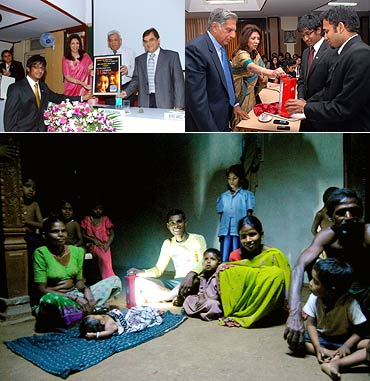
Today they are planning to scale up operations by tying up with a number of corporates. While HDFC is already sponsoring one village, they are in talks with a number of companies to sponsor others.
They are also in talks with various companies and young Indians to come on board as social entrepreneurs. It will be a social venture that will seek profits to sustain the business, its employees and the value chain it spawns.
"It is only through such initiatives will we be able to light up the dark villages in the entire country with solar energy," says Jyotirmoy.
For scaling up this business SIFE HRC is seeking interns from colleges who are looking out for summer jobs, so they can learn the complete Chirag Project experience.
"These interns will have to select the villages (near their villages/towns/cities), vendors, find a disadvantaged community that they will have to train to make solar lamps and engage the villagers on the benefits and simplicity of how these solar lamps work," says Prachi.
Jyotirmoy explains how Project Chirag helped them expand their horizons and how interns, who would join them, could benefit equally.
"This is like learning human resource management in college. It has given us good lessons in financial and production management, raw material management, quality assurance and control, logistics management, communicating with corporates, business ethics. When we started out we knew nothing about these aspects of managing a business. Now we know more than when we started," he explains.
Through these interns the young SIFE HRC volunteers want the Project Chirag footprint cast wide across India.
"It will be pointless to keep it limited only to SIFE HRC. We are willing to give any kind of support to those who want to be a part of Project Chirag and spread the idea throughout India for the benefit of the disadvantaged and backward people," says Prachi.
Ask them why, in the first place, did they tread this path and pat comes the reply: "It's not about talking, it's about doing; it's not about problems, it's about solving them. Everyone can do it."
If you are a college student and want to join SIFE HRC in Project Chirag you can contact them at sifehrc@gmail.com.
Image: Clockwise from top: Former HDFC Ltd Chairman Deepak Parekh inaugurating the 'Rs 10 for light' campaign along with HRC principal Dr Indu Shahani and SIFE HRC volunteers; Tata Sons Chairman Ratan Tata unveiling the first solar lantern assembled by the paraplegic community; A tribal Ujjaini family socialising at night with the help of the solar lamp.